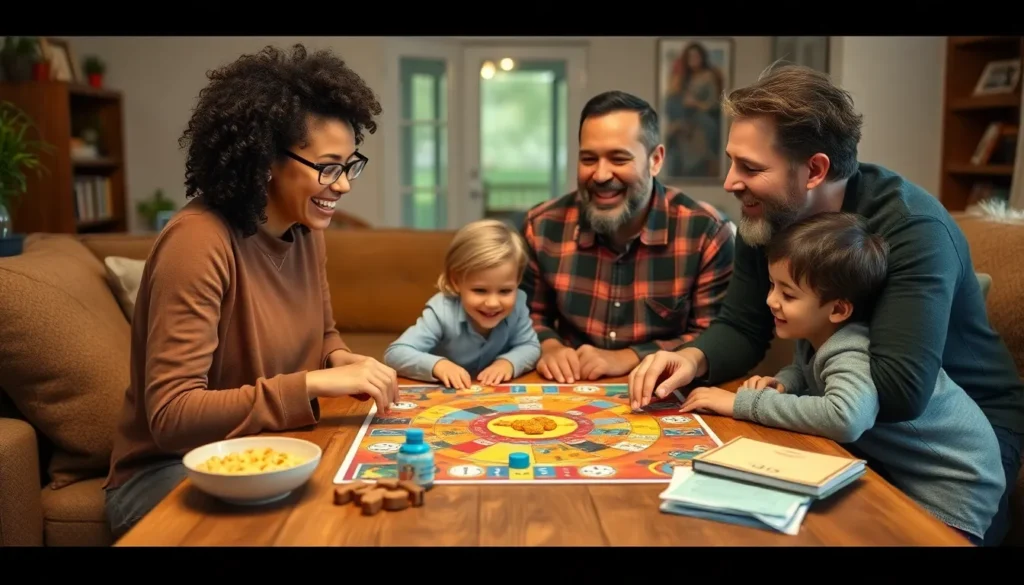Table of Contents
ToggleIn a world where competition often takes center stage, non-competitive family games offer a refreshing alternative. These games focus on collaboration, creativity, and fun, allowing family members to bond without the pressure of winning or losing. They create an environment where everyone can participate, fostering communication and teamwork among players of all ages.
From cooperative board games to imaginative outdoor activities, non-competitive options cater to diverse interests and skill levels. Families can explore new ways to connect, share laughter, and create lasting memories. Whether it’s a rainy day indoors or a sunny afternoon in the park, these games provide the perfect opportunity to strengthen family ties while enjoying quality time together.
Overview of Non-Competitive Family Games
Non-competitive family games serve as enjoyable activities that encourage connection without the pressure of competition. These games prioritize shared experiences, creativity, and teamwork.
Definition and Importance
Non-competitive family games are activities designed for players of all ages that emphasize participation over winning. They foster an inclusive environment where every family member can engage joyfully, regardless of skill levels. These games are essential for promoting healthy relationships, as they facilitate interaction and understanding among family members.
Benefits for Family Bonding
Non-competitive family games offer numerous benefits for strengthening family bonds.
- Enhances Communication: Games encourage conversations and interactions, helping family members express feelings and share thoughts.
- Builds Trust: Collaborative play fosters trust as family members rely on each other’s contributions.
- Encourages Teamwork: These games require working together, promoting cooperation towards a common goal.
- Fosters Creativity: Activities often allow players to think outside the box, leading to creative solutions and ideas.
- Creates Memories: Shared experiences during game time create lasting memories that families cherish.
Engaging in non-competitive family games nurtures relationships by cultivating a supportive atmosphere where families can enjoy each other’s company.
Types of Non-Competitive Family Games

Non-competitive family games come in various forms, each designed to enhance interaction and enjoyment among family members. The following categories highlight different types of non-competitive games suitable for all ages.
Board Games
Board games focus on cooperation and creativity rather than competition. Games like Pandemic, where players work together to fight global outbreaks, encourage teamwork and strategic thinking. The Game of Life allows players to navigate life decisions together, fostering discussion about choices and experiences. Non-competitive board games often feature unique themes and mechanics that emphasize collective goals and experiences.
Card Games
Card games offer flexibility and simplicity, making them ideal for family gatherings. Games like Uno (with house rules for cooperation) encourage players to strategize together, while Go Fish enhances communication skills among players of all ages. Non-competitive card games emphasize collaboration, with players focusing on shared objectives or cooperative storytelling.
Outdoor Games
Outdoor games promote physical activity and connection with nature. Activities like Capture the Flag (with teams working together to achieve a common goal) or Nature Scavenger Hunts encourage exploration and teamwork. Games like Frisbee or Capture the Balloon require cooperation and creativity, ensuring everyone participates in the fun. Engaging in outdoor non-competitive games builds rapport and strengthens family bonds in a lively environment.
How to Choose the Right Game
Selecting the right non-competitive family game involves considering various factors to maximize enjoyment and engagement for everyone involved. The following criteria help ensure a suitable choice.
Age Appropriateness
Choosing a game that aligns with age ranges enhances participation and enjoyment. Games should cater to the youngest family members, offering simpler mechanics and clear instructions. For example, games like Jenga or Duck, Duck, Goose suit younger children, while older kids and adults may appreciate games like Codenames or Telestrations. Ensuring all family members find the game accessible encourages teamwork and shared experiences.
Group Size Considerations
Consider group size when selecting a game, as some games naturally accommodate larger or smaller groups. Games like Pictionary work well for larger gatherings, promoting interactive play for teams. For smaller families, games like Story Cubes or Charades offer intimate and engaging experiences. Selecting a game appropriate for the number of players promotes inclusivity and shared enjoyment.
Game Duration
Game duration influences attention spans and family dynamics. Shorter games, such as Sushi Go! or Happy Salmon, keep energy levels high and allow for multiple rounds. Conversely, longer games like Forbidden Island offer deeper strategies and teamwork but may require breaks to maintain enthusiasm. Selecting games with suitable durations fosters sustained engagement and enjoyment among family members.
Tips for a Fun Game Night
Creating a lively and enjoyable game night enhances family bonding. Engaging everyone in a relaxed atmosphere cultivates enjoyable interactions and strengthens relationships.
Setting the Mood
Setting the mood contributes significantly to a successful game night. Choose a comfortable space with sufficient seating and good lighting. Use background music to create a lighthearted ambiance without distracting from game play. Prepare snacks and drinks for energy, keeping options varied to cater to different preferences. Consider using themed decorations to add excitement and enhance everyone’s experience.
Encouraging Participation
Encouraging participation ensures everyone feels included. Assign roles or tasks that fit each family member’s strengths, fostering a sense of ownership. Introduce simple rules to promote collaboration and focus on collective goals. Use humor and light-hearted banter to maintain a positive tone, making everyone feel comfortable voicing ideas and suggestions. Celebrate small achievements during the games to boost morale and engagement.
Dealing with Conflicts
Dealing with conflicts promptly maintains a fun environment. Establish a no-tolerance policy for harmful behaviors, fostering a supportive atmosphere. When disagreements occur, encourage open dialogue to address feelings and viewpoints respectfully. Use mediation techniques, such as taking turns speaking or allowing a time-out for cooling off, if necessary. Emphasizing the importance of fun over winning helps redirect focus towards collaboration and enjoyment.
Non-competitive family games offer a wonderful opportunity for families to connect in a relaxed environment. By focusing on participation rather than competition, these games foster collaboration and creativity. They create a space where laughter and shared experiences thrive, strengthening family bonds.
Choosing the right game can enhance the enjoyment and engagement of all family members. By considering factors like age appropriateness and group dynamics, families can ensure everyone feels included.
Ultimately, embracing non-competitive games transforms family time into cherished moments filled with joy and connection. It’s not just about playing; it’s about building lasting memories together.




